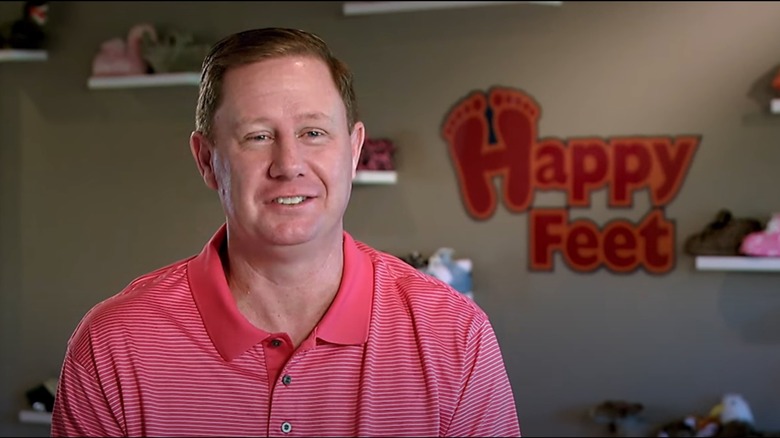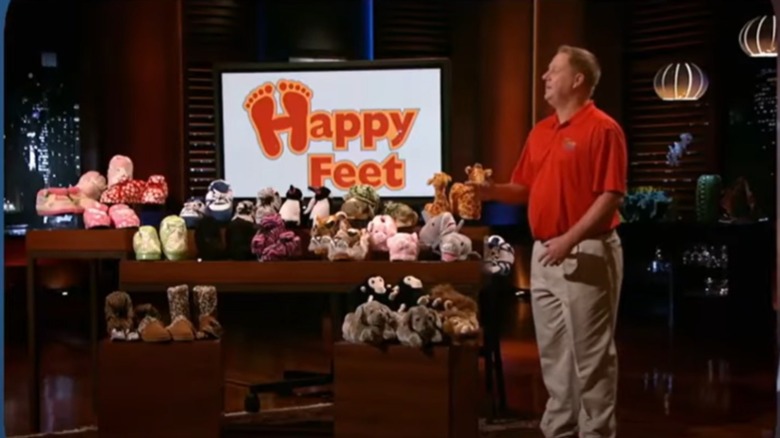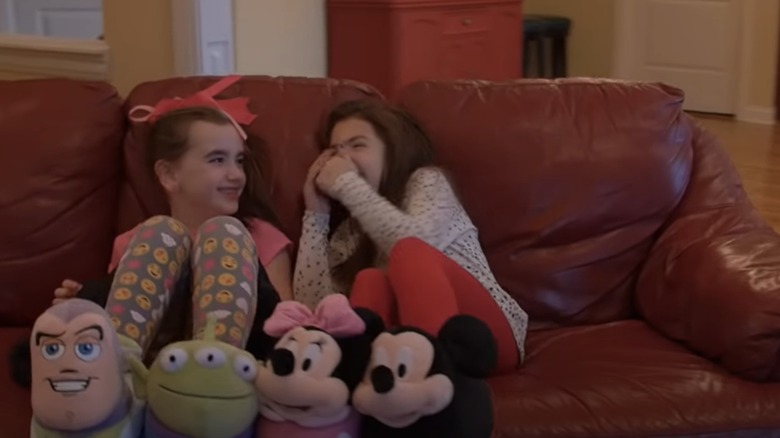What Happened To Happy Feet After Shark Tank?
We may receive a commission on purchases made from links.
When Pat Yates appeared on "Shark Tank" during Season 5, he was confident in his well-established product that had become a big hit at mall kiosks, online, and at fundraising events. He'd also been able to sell them wholesale to other companies. The concept was simple: a comfortable pair of house slippers designed to look like animals, football cleats, and even sneakers. With licensing from Disney and Marvel, Happy Feet has several shoes that resemble movie characters, such as Cinderella and Spiderman. Yates also successfully acquired licensing from the NCAA, NFL, NB, and MLB to use their logos and likeness on his vast sport-inspired selection.
At the time of his "Shark Tank" appearance, Yates had also begun collaborating with social media stars to help push the brand. One of the most notable names to promote Happy Feet was Nicole "Snooki" Polizzi, star of MTV's "Jersey Shore" franchise. With visibility via the internet, Yates still faced dilemmas. While he may have gotten some critiques from the Sharks, the smart businessman did not leave empty-handed.
There were concerns about getting Happy Feet into retail
Since founding Happy Feet in 1996, Pat Yates has brought in millions. When he appeared on the show in April 2014, Yates had accumulated $6.5 million in the three years leading up to his pitch. In 2013, he reported earning $2.6 million from the oversized slippers but was only turning a $650,000 profit. Yates explained that free shipping and the seasonal popularity of the business caused the money to take a hit. The 12% fee that he paid influencers to promote also consumed a large portion of the brand's money. Retail stores were reluctant to place the product in their physical locations due to Happy Feet potentially taking up too much space, and Kevin O'Leary didn't think it could happen. Additionally, Shark Barbara Corcoran, who always considers things carefully before investing, felt that the company was reaching its peak and would be declining in the near future.
Despite these critiques, what worked in the company's favor was that others seen selling the fluffy character slippers online or in malls were buying wholesale from Happy Feet, which meant the company was able to easily consume the market. Ultimately, Yates sought $375,000 in exchange for 15% of his company. O'Leary, Lori Greiner, and Robert Herjavec began to battle it out, making multiple offers to Yates. In the end, Herjavec was the one to seal the deal after initially turning away from the business, with a $375,000 boost for 25% equity in Happy Feet.
Happy Feet has added new products since Shark Tank
Since appearing on "Shark Tank," Happy Feet continues to thrive, even adding several new additions to its product line. Customers now have the option of purchasing head and ear protectors known as Headsokz, Pillow Palz, which are animal-shaped neck pillows, throw blankets and pillows, and an assortment of Plush stuffed animals. This variety of new products are listed under "Accessories" on the Happy Feet website, and all adhere to the same quality and soft standards seen in the slippers.
The pricepoint is roughly $27-$45, with a large selection on both its website and Amazon storefront — although closeout options on the Happy Feet website can be as low as $8. Thousands of product reviews are a testament to the comfortability and quality of the slippers.
The brand has an Instagram profile but doesn't update frequently and there don't seem to be any high profile influencers involved in helping to promote the festive bedroom shoes. Still, this has not deterred the progress of Happy Feet. The Shark Tank Blog (which is not affiliated with ABC) reports its annual revenue as $5 million a year, making it yet another "Shark Tank" success story.


